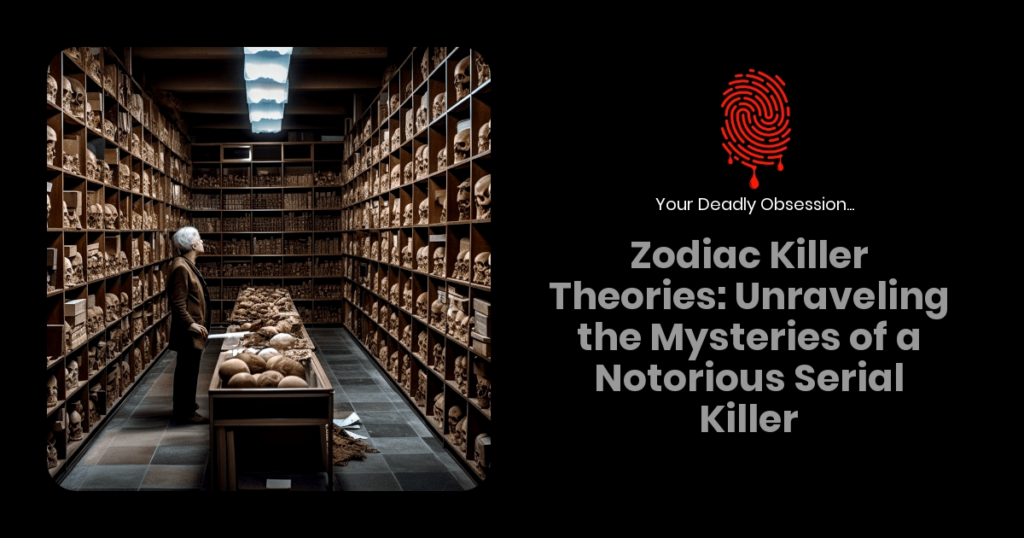The Zodiac Killer has intrigued and baffled both amateur and professional sleuths alike since the late 1960s. Responsible for a series of gruesome murders in Northern California, this shadowy figure’s identity remains unknown, despite the numerous theories that have emerged over the years. We’ll dive into some of the most compelling and provocative theories surrounding this infamous case.

Decoding the killer’s cryptic messages and ciphers has been an ongoing challenge for experts since the beginning. With portions of these messages still uncracked, the Zodiac Killer’s elusiveness continues to captivate even today. We’ll examine some of these well-known puzzles and the theories they’ve spawned.
As we delve into these various Zodiac Killer theories, we invite you to join us in exploring the puzzling and eerie details. Together, we’ll delve into the dark world of this mysterious murderer and the lingering questions that surround these chilling unsolved crimes.
An Overview of Zodiac Killer Theories
Zodiac Killer — a name that sends chills down the spines of many true crime fans. For decades, we’ve been fascinated by this enigmatic figure who terrorized Northern California during the late 1960s and early 1970s. The unsolved cases and cryptic messages attributed to the Zodiac Killer captivate us, and as a result, a wide range of theories have emerged. In this section, we’ll provide an overview of some of the most compelling and widely-discussed theories.
- The Suspects: Many people have been considered suspects in the Zodiac killings, but we’d like to focus on a few who gained the most attention:
- Arthur Leigh Allen: A convicted pedophile and one-time Zodiac Killer suspect, Allen’s handwriting and fingerprints were investigated but never conclusively linked to the Zodiac crimes.
- Richard Gaikowski: A San Francisco journalist with a high degree of knowledge in ciphers and cryptography, Gaikowski was also known to have exhibited unusual behavior.
- Ross Sullivan: Fitting the physical description of the Zodiac, Sullivan was an educated man with an interest in cryptograms and was even tied to a Zodiac-style murderthat occurred in Riverside, California.
- The Cryptograms: The Zodiac Killer sent numerous coded messages, some of which remain unsolved. These cryptograms are believed to contain vital clues:
- The 340-Character Cipher: Despite numerous attempts, this cryptogram remains unsolved, and many speculate it contains the Zodiac’s identity.
- The 408-Character Cipher: This cryptogram was solved by a California couple, revealing chilling messages that further fuel Zodiac theories.
- The Law Enforcement Theory: Some people believe that the Zodiac Killer was a police officer or someone with a working knowledge of law enforcement. The reasoning behind this theory is that the killer seemed to always stay a step ahead of the police, possibly due to their knowledge of police procedures.
- The Multiple Killers Theory: This theory suggests that there was more than one Zodiac Killer, possibly a team working together. Supporters of this idea point to the differing physical descriptions of the suspect and the possibility that multiple people could have written the letters and ciphers.
It’s important to remember that while the theories we’ve outlined here are compelling and thought-provoking, they’re only theories. The true identity and motives of the Zodiac Killer remain shrouded in mystery, allowing our imaginations to run wild as we ponder what might have driven this notorious criminal.
The Psychiatric Profiling Theory
When examining the Zodiac Killer case, it’s hard to ignore the potential role of psychiatric profiling in understanding and perhaps even identifying the notorious killer. In this section, we’ll delve into the psychiatric profiling theory, exploring what it entails and some expert opinions on the subject.
Psychiatric profiling involves using a suspect’s personality traits, behavior patterns, and social tendencies to generate a profile that can be used by investigators to solve a case. Experts like Dr. John E. Douglas, a former FBI special agent and criminal profiler, have provided insights into the Zodiac Killer’s possible psychological makeup:
- Narcissism: The Zodiac Killer showed signs of narcissistic personality traits, as indicated by the taunting letters sent to newspapers and law enforcement. This suggests a desire for attention and notoriety.
- Control: The meticulous planning and execution of the murders imply a need for control and order, which could lead to rigid thinking and a lack of empathy for the victims.
- Intelligence: It’s believed the killer had a relatively high level of intelligence, as demonstrated by the complex cryptograms included in some of the letters.
Several psychiatrists have weighed in on the Zodiac Killer case, offering their unique perspectives. For example, psychiatrist Dr. James L. Lukefahr proposed a theory that the killings were an attempt to fulfill a delusional mission by the killer. This mission, according to Dr. Lukefahr, revolved around astrology, specifically the killer’s belief in the power of the Zodiac.
While no theory has conclusively helped to solve the Zodiac Killer case, the psychiatric profiling offers us a lens through which we can understand the possible motives and behaviors of the killer. It’s important to consider that the following profiling elements are speculative, but could offer more insights:
- Signature: A killer’s “signature” refers to specific, repetitive behaviors unique to that individual. In the Zodiac case, these might include the manner in which the victims were killed, the use of cryptograms, and the taunting letters sent to the media.
- Motive: For the Zodiac Killer, the motive could be linked to delusional beliefs or a need for power and control. Identifying a more precise motive could be key to understanding the killer’s rationale.
As we explore the Zodiac Killer theories, it’s important to keep an open mind and recognize that multiple theories may contain elements of truth. While psychiatric profiling is not a foolproof method, it has provided valuable insights in many cases and remains a vital tool in the field of criminal investigation.
The Group Murder Theory
One of the intriguing theories surrounding the Zodiac Killer case is the Group Murder Theory. This hypothesis suggests that multiple people, perhaps working together, were responsible for the murders attributed to the Zodiac. Let’s examine some of the possible reasons behind this theory, as well as the evidence supporting it.
Firstly, the variation in the killer’s methods and weapons has led some to believe that multiple individuals were involved. The Zodiac killings were carried out using different weapons and methods, which include stabbings and shootings. This inconsistency has fueled speculation that a group of individuals with distinct preferences might have been responsible.
Another point to consider is the discrepancy in the physical descriptions of the Zodiac. Witnesses provided varying descriptions of the killer. While some similarities exist, these discrepancies have led to the theory that there might be more than one person fulfilling the role of the Zodiac Killer. To illustrate, here’s a markdown table detailing a few witness descriptions:
| Witness | Description of Zodiac Killer |
|---|---|
| Hartnell & Shephard | Heavyset man, 5’10” to 6′, weighing over 200 lbs |
| Mageau | 26 to 30 years old, 5’8″ to 5’9″, 160 to 180 lbs, short curly hair |
Furthermore, the complexity of the Zodiac messages and ciphers may suggest collaboration. The Zodiac Killer sent numerous letters and cryptograms to newspapers, taunting the police and public with his encrypted messages. Some experts believe that the intricacy of these ciphers could indicate involvement from multiple skilled individuals.
Finally, the seemingly random selection of victims and crime locations may hint at multiple assailants’ presence. The victims included:
- Couples parked in secluded areas
- A cab driver
- A male college student
These diverse murder scenarios led some to believe that different perpetrators might have been targeting various types of victims.
While the Group Murder Theory provides an interesting explanation for some aspects of the Zodiac Killer case, it’s important to remember that this is just one of many theories. With a lack of substantial evidence, it’s difficult to determine the plausibility of a group being behind these notorious crimes. Nevertheless, as we unravel the mysteries surrounding the Zodiac killings, this perspective continues to spark fascination and debate among cold case enthusiasts.
The Military Connection Theory
Throughout our exploration of various Zodiac Killer theories, one that we can’t ignore is the Military Connection Theory. This theory asserts that the infamous serial killer had a military background or connections to the armed forces. Let’s dive deeper into the reasons behind this hypothesis.
Knowledge of Ciphers and Codes
The Zodiac Killer is notorious for sending complex encrypted messages to newspapers, boasting about their crimes. The use of ciphers and codes suggests that the killer may have had military training or familiarity with cryptography:
- The 340-character cipher was cracked by a team of codebreakers in 2020, revealing phrases such as “I am not afraid” and “I am the zodiac slain.”
- The killer used a symbol from the World War II-era U.S. Navy flag semaphore, implying a possible naval connection.
Military-Style Clothing and Weapons
Some Zodiac crimes were committed using military-style gear and weapons, further fueling speculation:
- In the Lake Berryessa attack, the killer wore an executioner-style hood with a white crosshair design over the chest. This resembles the reticle used in military aiming devices.
- The use of a .22 caliber pistol with a modified flashlight affixed to the barrel, as seen in the murder of cab driver Paul Stine, could also suggest a link to military tactics.
Disciplined Approach and Psychological Warfare
The Zodiac Killer’s methodical and often taunting approach bears some resemblance to certain elements of military strategy:
- Their crimes were executed with a disciplined approach, often leaving little evidence behind.
- They utilized psychological warfare techniques to instill fear in their victims and the public, reminiscent of strategies employed by the military.
Suspects with Military Connections
Several key suspects in the Zodiac case had military ties, adding weight to this theory:
- Arthur Leigh Allen: Served in the U.S. Navy and was stationed at the same base as noted cryptanalyst Ross T. Snelling.
- Richard Gaikowski: Was in the U.S. Army during the 1960s, where he worked with cryptographic equipment.
- Earl Van Best, Jr.: Served in the U.S. Air Force and had experience working with electronics and communication equipment.
As we continue to investigate the Zodiac Killer’s identity, the Military Connection Theory remains a compelling angle to consider. However, it’s essential not to make exaggerated or false claims and to maintain objectivity as we search for the truth.
The Unsubstantiated Suspects Theory
Over the years, many theories have surfaced regarding the identity of the Zodiac Killer. Some of these theories include a list of unsubstantiated suspects that haven’t held up to scrutiny, often due to a lack of concrete evidence. In this section, we’ll delve into some of these theories and potential suspects.
One theory suggests that the Zodiac Killer could have been a military man – specifically, a member of the U.S. Navy. This theory is largely based on the idea that the killer may have had military-grade ciphers, which would explain the encrypted messages that he sent to the local police departments and newspapers. While this theory might seem plausible, there’s no substantial evidence to back it up, and many of the Zodiac’s ciphers continue to stump authorities and codebreakers alike.
Various other unsubstantiated suspects include people with criminal records or a history of mental health issues. The most famous of them all is Arthur Leigh Allen. Despite being considered by some as the prime suspect, there’s still no definitive proof connecting Allen to the Zodiac crimes. Other possible suspects include:
- Bruce Davis
- Ross Sullivan
- Lawrence Kane
However, none of these suspects can be confidently tied to the murders, as their involvement remains unproven.
There’s also the possibility that the Zodiac Killer wasn’t just one individual, but rather a group of people working together. This theory claims that the murders could have been the work of a team of people, hence the lack of a consistent suspect profile. Again, though, this notion is not backed up by any concrete evidence.
In summary, while there are numerous theories surrounding the identity of the Zodiac Killer, many of which involve a list of unsubstantiated suspects, none have provided an accurate and conclusive answer. The case remains a mystery, and as time goes on, it becomes increasingly difficult to uncover the truth. Theories will continue to emerge, and die-hard fans of cold cases, crime and mystery will keep digging into the seemingly unsolvable puzzle of the Zodiac Killer.
What was the Zodiac killer’s real name?

The Zodiac Killer’s real name remains unknown. Despite extensive investigations and numerous suspects, the killer’s identity has never been conclusively established.
Who is the zodiac prime suspect?
There isn’t a definitive prime suspect in the Zodiac Killer case, as the identity of the killer remains unknown. Numerous suspects have been proposed over the years, but none have been conclusively linked to the crimes.
Conclusion: Debating the Zodiac Killer Theories
Throughout this article, we’ve carefully examined various theories surrounding the elusive Zodiac Killer. Each theory has its own merits and shortcomings, but we must acknowledge that none has conclusively identified the notorious criminal. As die-hard fans of cold cases, crime, and mystery, let’s recap some of the key points we covered:
- The most popular suspects include Arthur Leigh Allen, Rick Marshall, and Lawrence Kane. While no definitive evidence links them to the killings, strong circumstantial evidence keeps them in the spotlight.
- The decryption and analysis of the Zodiac’s coded messages revealed a twisted mind that craved attention from both law enforcement and the public.
- Copycat killers have been proposed as a possible explanation for some of the Zodiac’s crimes, potentially confusing the investigation.
As we reach the end of our exploration, one thing remains clear: the Zodiac Killer case sparks numerous debates and discussions among true crime enthusiasts. Some key elements in this ongoing discussion are:
- The strengths and weaknesses of each suspect.
- Possible errors in law enforcement’s approach to the case.
- Continuing efforts to decrypt the still-unsolved ciphers.
- New breakthroughs and discoveries that may shed light on the killer’s identity.
Despite the many years since the Zodiac Killer’s reign of terror, we remain fascinated by the case and the mysteries it presents. We’ll continue to search for answers, piecing together the puzzle until the day this enigmatic figure is unmasked.
References:
- https://www.sfchronicle.com/chronicle_vault/article/Chronicle-Covers-When-the-Zodiac-killer-wrote-to-9961233.php
- https://www.huffingtonpost.com/entry/dna-zodiac-killer_us_5af0c840e4b0ab5c3d68bc90
- http://www.zodiackillerthemansonconnection.com/davis.html

Owner & entrepreneur with a passion for murder mystery! Seriously, who doesn’t love murder mystery?
Chris is a proud member of the American Medical Writer’s Association (AMWA), the International Society for Medical Publication Professionals (ISMPP), the National Association of Science Writers (NASW), the Council of Science Editors, the Author’s Guild, and the Editorial Freelance Association (EFA).

